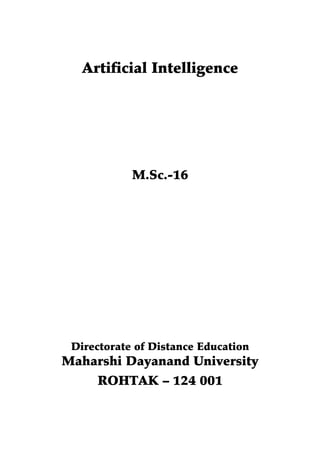
Contents
- 1. Artificial Intelligence M.Sc.-16 Directorate of Distance Education Maharshi Dayanand University ROHTAK – 124 001
- 2. Copyright © 2002, Maharshi Dayanand University, ROHTAK All Rights Reserved. No part of this publication may be reproduced or stored in a retrieval system or transmitted in any form or by any means; electronic, mechanical, photocopying, recording or otherwise, without the written permission of the copyright holder. Maharshi Dayanand University ROHTAK – 124 001 2
- 3. Developed & Produced by EXCEL BOOKS, A-45 Naraina, Phase 1, New Delhi-110028 3
- 4. Contents UNIT 1 WHAT IS ARTIFICIAL INTELLIGENCE 1 Artificial Intelligence: An Introduction AI Problems AI Techniques Games Theorem Proving Natural Language Processing Vision and Speech Processing Expert System Search Knowledge Abstraction UNIT 2 PROBLEM, PROBLEM SPACE AND SEARCH 21 Defining Problem as a State Space Production System Search Space Control Strategy Breadth First Search and Depth First Search Problem Characteristics Heuristic Search Techniques Generate and Test Hill Climbing Best First Search Branch and Bound Problem Reduction Constraints Satisfaction Means End Analysis 4
- 5. UNIT 3 KNOWLEGE REPRESENTATION 64 Representation and Mapping Approaches to Knowledge Representation The Frame Problem UNIT 4 REPRESENTING SIMPLE FACTS IN LOGIC 87 Representing Simple Facts in Logic Representing Instance and is a Relationships Modus Pones Resolutions (Skolemizing Queries) Unification Dependency Directed Backtracking UNIT 5 RULE BASED SYSTEMS 125 Procedural Versus Declarative Knowledge Forward Reasoning Backward Reasoning Conflict Resolution Use of Non Backtrack UNIT 6 STRUCTURES KNOWLEDGE REPRESENTATION SEMANTIC NET 139 Semantic Nets Frames Slots Exceptions Handling Uncertainties Probabilistic Reasoning Use of Certainty Factors Fuzzy Logic UNIT 7 LEARNING 178 Concept of Learning 5
- 6. Learning Automation Genetic Algorithm Learning by Induction Neural Networks Learning in Neural Networks Back Propagation Network UNIT 8 EXPERT SYSTEMS 224 Need and Justification of Expert Systems Knowledge Acquisition Case Studies MYCIN RI 6
- 7. UNIT 3 KNOWLEGE REPRESENTATION 64 Representation and Mapping Approaches to Knowledge Representation The Frame Problem UNIT 4 REPRESENTING SIMPLE FACTS IN LOGIC 87 Representing Simple Facts in Logic Representing Instance and is a Relationships Modus Pones Resolutions (Skolemizing Queries) Unification Dependency Directed Backtracking UNIT 5 RULE BASED SYSTEMS 125 Procedural Versus Declarative Knowledge Forward Reasoning Backward Reasoning Conflict Resolution Use of Non Backtrack UNIT 6 STRUCTURES KNOWLEDGE REPRESENTATION SEMANTIC NET 139 Semantic Nets Frames Slots Exceptions Handling Uncertainties Probabilistic Reasoning Use of Certainty Factors Fuzzy Logic UNIT 7 LEARNING 178 Concept of Learning 5
